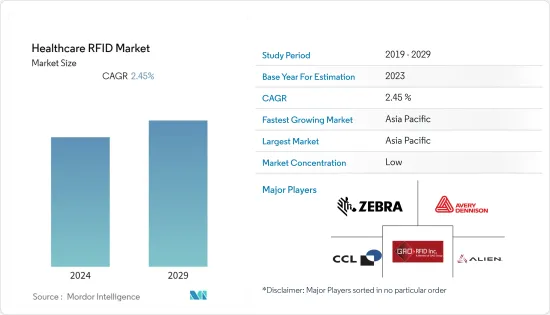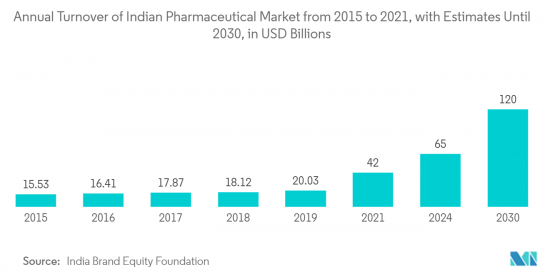 |
市場調查報告書
商品編碼
1404394
醫療保健 RFID:市場佔有率分析、行業趨勢和統計、2024-2029 年成長預測Healthcare RFID - Market Share Analysis, Industry Trends & Statistics, Growth Forecasts 2024 - 2029 |
||||||
※ 本網頁內容可能與最新版本有所差異。詳細情況請與我們聯繫。
本會計年度醫療保健 RFID 市場估計為 12.3107 億美元。
預計五年內將達到 13.8945 億美元,預測期內複合年成長率為 2.45%。

RFID 技術正在對世界各地的醫院、診所、衛生系統、經銷商和製造商產生重大影響,並有望在未來幾年取得更大的收益。 RFID在醫療領域的採用促使更多的製藥公司在藥品標籤上貼上RFID標籤來管理其供應鏈。因此,RFID的採用可能會繼續在醫療領域發揮更重要的作用。
主要亮點
- 幾十年來,跨國製藥公司一直在世界各地生產和銷售藥品。然而,標籤是一項嚴格而艱鉅的挑戰,而且其複雜性只會越來越大。新的標籤法規因國家和地區而異,預計將顯著刺激 RFID 市場的成長,迫使製藥公司要么建立滿足全球需求的系統,要么聘請專家來這樣做。
- 將 RFID 融入藥品將使整個供應鏈的藥品管理和認證更加準確,旨在將錯誤消除到接近零,從而提高患者的安全。此外,它還消除了昂貴且更重要的是集中的醫院內藥物標籤的需要,從而減輕了醫院工作人員的重大負擔。
- RFID還可應用於醫院和藥房的庫存管理,確保品質並消除浪費。其好處超出了投資回報,因為 RFID 具有拯救生命的潛力。這就是為什麼行業參與者正在組裝產品系列,其中包括防篡改 RFID 標籤和發光標籤,以便為藥房、醫院和患者提供關鍵資訊。這些智慧 RFID 解決方案有助於降低成本、提高準確性並加快業務速度,同時保護製藥品牌免於仿冒。
- 阻礙市場發展的因素包括醫療保健 RFID 系統的高實施成本和系統互通性。採用 RFID 的行業必須在操作讀取器、標籤、軟體、電力和交換服務方面進行大量投資。物聯網組件整合、系統可靠性測試和培訓成本等附加功能增加了 RFID 解決方案的成本。
- 在 COVID-19 大流行期間,醫院正在使用 RFID 技術更好地管理患者和工作人員。醫療產業在採用 RFID 設備方面取得了重大進展,RFID 設備使用無線電波來識別和追蹤資產和設備。當醫療團隊繼續面臨突發公共衛生事件時,RFID 可能會提高他們的效率和課責。
醫療保健 RFID 市場趨勢
檢查生長的藥物
- 隨著製造商擴大支援具有 RF 標籤識別功能的智慧標籤,並且藥品與其他製藥技術解決方案的互通性越來越強,越來越多的醫院和醫療保健系統開始採用RFID 標籤進行設施內藥品追蹤。
- 然而,製藥業也採用 RFID 來防止各種處方箋藥的假冒,從而增加了供應鏈和業務效益。由於技術不斷進步,製造商可以利用資料分析技術和RFID技術來準確分析消耗和庫存資料。加州藥房委員會強制要求在供應鏈中實施 e-Pedigree 等監管要求也將為製藥業帶來對 RFID 的巨大需求。
- 醫療 RFID 市場受到製藥業日益嚴格的法規環境的顯著推動。在製藥業,各國政府和其他監管機構採取了嚴格措施,以減少仿冒品和其他健康問題造成的問題。
- 一旦處方箋進入藥櫃,製藥公司就會尋求改進的方法來管理整個供應鏈的藥品。由於其資料採集和傳輸能力,RFID目前被視為這一問題的答案。製藥業尋求透過提高品質、降低成本、最重要的是提高病患安全來實現這一目標。

亞太地區成長迅速
- RFID在醫療領域有著廣泛的應用,包括對病患和醫療設備的持續和直接追蹤。 RFID 幫助醫療保健專業人員提高和加快護理質量,減少醫療錯誤,並消除大量資料收集、完整性、輸入和驗證,包括患者識別、藥物檢查和患者轉診。工作。
- 對該地區市場成長產生積極影響的關鍵因素是醫療保健成本的上升和醫療保健基礎設施的改善。促進區域發展的成長要素,例如醫院附屬醫療保健人員數量的增加、法規結構的改進、患者安全的優先考慮以及醫療設備的追蹤,由於疾病負擔的增加而增加了對高效醫療保健服務的需求。 .預計促進
- 此外,資產追蹤 RFID 解決方案的使用正在澳洲不斷擴大。醫院和養老機構必須處理大量一次性物品,例如繃帶、針頭和個人防護裝備。被動 RFID 標籤可貼在裝有消耗品和一次性物品的盒子上。
- 然而,RFID技術廣泛應用於醫療產業,例如醫療設備、機械和支援設備。醫療 RFID 市場的成長是由於擴大使用 RFID 來監控各種醫療保健環境中的這些設備,以提供高效的患者照護。
醫療保健 RFID 產業概述
醫療保健 RFID 市場主要由多個地區和國際參與企業組成,使其成為一個競爭相當激烈的市場。此外,公司也透過技術進步獲得持續的競爭。物聯網和雲端運算等技術正在改變市場開拓。總體而言,供應商之間的競爭在整個期間都非常激烈,並且預計將持續下去。該市場的主要企業包括 Alien Technology Corporation、Zebra Technologies Corporation、CCL Industries Inc.、Avery Dennison Corporation 和 Biolog-id GAO RFID, Inc.。
2023年6月,Ascom和德國Niels-Stensen-Kliniken集團將實施Ascom的創新警報系統解決方案和IP-DECT基礎設施,實現醫療基礎設施的數位化,最佳化總體成本,同時增加我們宣布已簽訂合約協議,這將使我們能夠確保高效、優質的患者照護。
2023 年 3 月,Zebra Technologies Corporation 宣布 Alpro Pharmacy 實施了 Zebra 的行動運算和 RFID 解決方案,以實現其手動庫存管理系統的數位化並為其快速成長的業務提供動力。數位化的階段是為 Alpro Pharmacy 的第一線員工配備 Zebra 的 TC21 觸控電腦,取代手動紙筆庫存管理系統。部署行動裝置來協助完成所有庫存管理業務,從在 Alpro Pharmacy 配送中心接收產品到為零售和電子商務訂單挑選產品。該解決方案將 Alpro Pharmacy 的效率提高了約 80%,並透過減少人為錯誤提高了準確性。
其他福利:
- Excel 格式的市場預測 (ME) 表
- 3 個月的分析師支持
目錄
第1章簡介
- 研究假設和市場定義
- 調查範圍
第2章調查方法
第3章執行摘要
第4章市場洞察
- 市場概況
- 產業價值鏈分析
- 產業吸引力-波特五力分析
- 供應商的議價能力
- 買家/消費者的議價能力
- 新進入者的威脅
- 替代品的威脅
- 競爭公司之間敵對關係的強度
- 評估 COVID-19 對產業的影響
第5章市場動態
- 市場促進因素
- 製藥業對藥品標籤的監管收緊
- 增加 RFID 設備在醫療領域的應用與使用
- 市場抑制因素
- 開發替代標籤方法
第6章市場區隔
- 依產品
- 標籤和標籤
- 射頻識別系統
- 資產監控系統
- 病患監測系統
- 藥品監控系統
- 血液監測系統
- 按最終用戶
- 醫院
- 製藥公司
- 其他最終使用者(研究所、實驗室)
- 按地區
- 北美洲
- 美國
- 加拿大
- 墨西哥
- 歐洲
- 德國
- 英國
- 法國
- 義大利
- 西班牙
- 歐洲其他地區
- 亞太地區
- 中國
- 日本
- 印度
- 澳洲
- 韓國
- 其他亞太地區
- 南美洲
- 中東/非洲
- 北美洲
第7章競爭形勢
- 公司簡介
- Zebra Technologies Corporation
- Avery Dennison Corporation
- CCL Industries Inc.
- Alien Technology Corporation
- GAO RFID, Inc
- Honeywell International Inc.
- S3Edge Inc.
- STANLEY Healthcare
- Biolog-id
- Impinj Inc.
- Mobile Aspects Inc.
- RF Technologies
- STid Groupe
- Terso Solutions Inc.
- Spacecode Technologies
第8章投資分析
第9章市場的未來

The RFID Market in Healthcare was estimated at USD 1,231.07 million in the current year. The market is expected to reach USD 1,389.45 million in five years, registering a CAGR of 2.45% during the forecast period.
RFID technology has significantly impacted hospitals, clinics, healthcare systems, distributors, and manufacturers worldwide but is due to achieve even more in years to come. The adoption of RFID in the medical field has become a catalyst for more and more pharmaceutical companies to put RFID tags on medicine labels to control their supply chain. The adoption of RFID will thus continue to have a more vital role in the healthcare sector.
Key Highlights
- Multinational pharmaceutical companies have been manufacturing medicines for decades to distribute worldwide. Labelling, however, is a rigorous and challenging task that continues to grow more complex. With new labeling regulations that can vary widely across the country and region, which are predicted To stimulate growth in the RFID market by a large margin, pharmaceutical companies must either build their systems to meet global needs or delegate them to experts to be able to do so.
- Integrating RFID in pharmaceutical products will help increase patient safety because it allows for more precise control and authentication of medicinal products throughout the supply chain, aiming to reduce errors to almost zero. In addition, it eliminates the need for costly and, more importantly, labor-intensive in-house medication labeling, thereby relieving a significant burden on hospital staff.
- RFID may be applied for inventory management at hospitals and pharmacies to ensure quality and reduce waste. The benefits go beyond the return on investment since it has the potential to save lives. That is why, to provide pharmacies, hospitals, and patients with critical information, industry players are putting together a premium product portfolio that includes tamper-evident RFID tags and luminous labels; these smart RFID solutions will help to reduce costs, raise accuracy, and speed up operations while protecting pharmaceutical brands from counterfeiting.
- A few factors slowing down the market studied include high installation costs for RFID systems in healthcare and system interoperability. Any industry adopting RFID must invest significantly in readers, tags, software, electricity, and operating replacement services. Additional features such as integration of Internet of Things components, system reliability testing, and training costs add to the cost of an RFID solution.
- Hospitals use RFID technology to manage patients and staff better during pandemics due to the COVID-19 outbreak. The healthcare industry has seen a great uptake of RFID devices, which use radio waves to identify and track assets and equipment. RFID will increase the efficiency and accountability of healthcare teams as we continue to face a Public Health Emergency.
RFID in Healthcare Market Trends
Pharmaceuticals to Witness the Growth
- More hospitals and healthcare systems are beginning to adopt RFID tags for tracking medication inside their facilities as manufacturer-enabled smart labels with RF tag identification increases, in addition to more interoperability between medications and other pharmacy technology solutions.
- However, RFID has also been adopted by the pharmaceutical industry to prevent the counterfeiting of different prescription medicines with added supply chains and operational benefits. As a result of continued technological advancement, manufacturers can accurately analyze consumption and inventory data using data analysis techniques and RFID technology. As mandated by the California Board of Pharmacy, regulatory demands such as implementing e-Pedigree in the supply chain will also generate substantial demand for RFID in the pharmaceutical sector.
- The healthcare RFID market has been significantly driven by an increasingly strict regulatory environment in the pharmaceuticals sector. In the field of pharmaceuticals, stringent measures have been introduced by governments and other regulatory bodies throughout different countries to reduce problems caused by counterfeits and other health issues.
- Once a prescription has been put in the medicine cabinet, pharmaceutical companies look for improved ways of controlling their medicines throughout the supply chain. RFID is currently regarded as the answer to this question due to its capacity for capturing and transmitting data. The pharmaceutical industry tries to achieve that by improving quality, reducing costs, or, most of all, enhancing patient safety.

Asia Pacific to Register Fastest Growth
- RFID is applied to a wide range of applications in the healthcare sector, such as constant and direct patient or medical device tracking. It helps and supports healthcare professionals to improve and promote healthcare quality, decreases medical errors, and optimizes and automates the healthcare process by carrying out large amounts of work in data collection, integrity, entry, and confirmation such as patient identification, pharmaceuticals checks, and patient referrals, among others.
- The main factors positively influencing growth in the region's market are rising medical costs and improved healthcare infrastructure. Growth factors contributing to regional development, including the increasing number of healthcare professionals associated with hospitals, improved regulatory framework, prioritizing patient safety, and tracking medical devices, are expected to drive demand for efficient health services due to the rising disease burden.
- In addition, the use of RFID solutions to track assets is widespread in Australia. Large quantities of disposable goods like bandages, needles, and personal protection equipment must be handled by hospitals and elderly care facilities. Box containing consumables and disposable items may be fitted with passive RFID tags.
- However, RFID technology has been extensively used in the healthcare industry, for instance, in medicine devices, machinery, and support equipment. The growth of the healthcare RFID market is fueled by the increasing use of RFID to monitor these devices in different health environments to provide efficient patient care.
RFID in Healthcare Industry Overview
The RFID market in healthcare primarily comprises multiple regional and international players in a fairly contested market space. Furthermore, firms gain a sustained competitive edge due to technological progress. Technologies like the Internet of Things and cloud computing are altering market developments. Overall, it is anticipated that the intensity of competitive competition between vendors will be high throughout the period under review and continue to do so. Some key players in the market are Alien Technology Corporation, Zebra Technologies Corporation, CCL Industries Inc., Avery Dennison Corporation, and Biolog-id GAO RFID, Inc., among others.
In June 2023, Ascom announced a contract agreement with Niels-Stensen-Kliniken Group in Germany with the installation of the Ascom innovative alarming system solution and IP-DECT infrastructure and Digitization of the healthcare infrastructure, making it possible to ensure more efficient and better patient care while optimizing overall costs.
In March 2023, Zebra Technologies Corporation announced that Alpro Pharmacy had introduced Zebra's mobile computing and RFID solutions to digitalize its manual inventory management system to advance its fast-growing business. The first stage of digitalization was to equip Alpro Pharmacy's front-line workers with Zebra's TC21 touch computers to replace their manual inventory management system using pen and paper. The mobile devices were introduced to assist with all inventory management tasks, from receiving goods at Alpro Pharmacy's distribution center to picking goods for its retail stores and e-commerce orders, to name a few. The solution has since enhanced Alpro Pharmacy's efficiency by approximately 80% and improved its accuracy by reducing human errors.
Additional Benefits:
- The market estimate (ME) sheet in Excel format
- 3 months of analyst support
TABLE OF CONTENTS
1 INTRODUCTION
- 1.1 Study Assumptions and Market Definition
- 1.2 Scope of the Study
2 RESEARCH METHODOLOGY
3 EXECUTIVE SUMMARY
4 MARKET INSIGHTS
- 4.1 Market Overview
- 4.2 Industry Value Chain Analysis
- 4.3 Industry Attractiveness - Porter's Five Forces Analysis
- 4.3.1 Bargaining Power of Suppliers
- 4.3.2 Bargaining Power of Buyers/Consumers
- 4.3.3 Threat of New Entrants
- 4.3.4 Threat of Substitute Products
- 4.3.5 Intensity of Competitive Rivalry
- 4.4 Assessment of the Impact of COVID-19 on the Industry
5 MARKET DYNAMICS
- 5.1 Market Drivers
- 5.1.1 Growing Stringency in the Pharmaceutical Sector with Regards to Medicine Labeling
- 5.1.2 Increased Applications and Use of Devices Supporting RFID Across the Healthcare Sector
- 5.2 Market Restraints
- 5.2.1 Development of Alternate Labeling Methods
6 MARKET SEGMENTATION
- 6.1 By Product
- 6.1.1 Tags and Labels
- 6.1.2 RFID Systems
- 6.1.2.1 Asset Tracking Systems
- 6.1.2.2 Patient Tracking Systems
- 6.1.2.3 Pharmaceutical Tracking Systems
- 6.1.2.4 Blood Monitoring Systems
- 6.2 By End User
- 6.2.1 Hospitals
- 6.2.2 Pharmaceuticals
- 6.2.3 Other End Users (Research Institutes and Laboratories)
- 6.3 By Geography
- 6.3.1 North America
- 6.3.1.1 United States
- 6.3.1.2 Canada
- 6.3.1.3 Mexico
- 6.3.2 Europe
- 6.3.2.1 Germany
- 6.3.2.2 United Kingdom
- 6.3.2.3 France
- 6.3.2.4 Italy
- 6.3.2.5 Spain
- 6.3.2.6 Rest of Europe
- 6.3.3 Asia Pacific
- 6.3.3.1 China
- 6.3.3.2 Japan
- 6.3.3.3 India
- 6.3.3.4 Australia
- 6.3.3.5 South Korea
- 6.3.3.6 Rest of Asia Pacific
- 6.3.4 South America
- 6.3.5 Middle East & Africa
- 6.3.1 North America
7 COMPETITIVE LANDSCAPE
- 7.1 Company Profiles
- 7.1.1 Zebra Technologies Corporation
- 7.1.2 Avery Dennison Corporation
- 7.1.3 CCL Industries Inc.
- 7.1.4 Alien Technology Corporation
- 7.1.5 GAO RFID, Inc
- 7.1.6 Honeywell International Inc.
- 7.1.7 S3Edge Inc.
- 7.1.8 STANLEY Healthcare
- 7.1.9 Biolog-id
- 7.1.10 Impinj Inc.
- 7.1.11 Mobile Aspects Inc.
- 7.1.12 RF Technologies
- 7.1.13 STid Groupe
- 7.1.14 Terso Solutions Inc.
- 7.1.15 Spacecode Technologies













